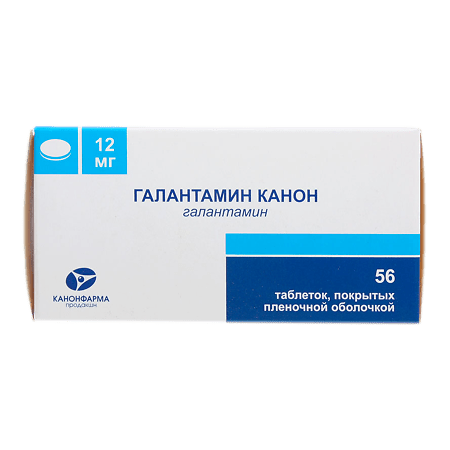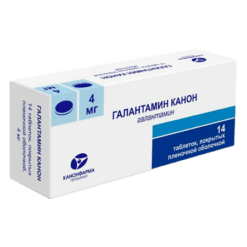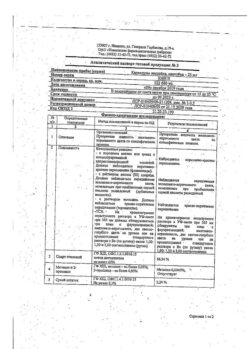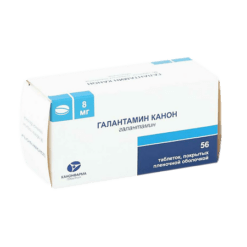No products in the cart.
Galantamine Canon, 12 mg 56 pcs
€120.43 €100.36
Description
A selective, competitive and reversible acetylcholinesterase inhibitor. Stimulates nicotinic receptors and increases sensitivity of postsynaptic membrane to acetylcholine. Facilitates excitation conduction in neuromuscular synapse and restores neuromuscular conduction in cases of its blockade by myorelaxants of non-depolarizing type of action.
It increases tone of smooth muscles, increases secretion of digestive and sweat glands, causes miosis. By increasing the activity of cholinergic system, galantamine improves cognitive functions in patients with Alzheimer type dementia, but does not influence the development of the disease itself.
Pharmacokinetics
The pharmacokinetics of galantamine are linear in the dose range
4 -16 mg 2 times daily.
Intestation
After a single oral dose of 8 mg, galantamine is rapidly absorbed from the gastrointestinal tract (GIT). The maximum concentration (Cmax) in plasma is reached after 1.2 hours and is approximately 43 ng/ml, the area under the curve “concentration-time” (AUC) is
427 ng x h/ml.
Distribution
The absolute bioavailability when taken orally is 88.5%. Taking galantamine with food slows its absorption (Cmax decreases by 25%), but does not affect the area under the curve “concentration-time” (AUC). After multiple doses of galantamine at a dose of 12 mg 2 times per day, the mean end-of-course concentrations and Cmax in plasma vary from 30 ng/ml to 90 ng/ml.
The volume of distribution is 175 ml. The binding of galantamine to plasma proteins is about 18%. In whole blood, galantamine is predominantly found in the form cells (52.7%) and in plasma (39%), whereas its fraction bound to plasma proteins is only 8.4%.
Metabolism
In vitro studies have shown that the main isoenzymes of the cytochrome P450 system involved in galantamine metabolism are the CYP2D6 isoenzyme, with which the formation of O-demethylgalantamine is associated, and the CYP3A4 isoenzyme, with which the formation of N-oxydgalantamine is associated.
The amounts of radioactive substances excreted in the urine and feces did not differ in people with fast and slow metabolism. In the plasma of people with fast and slow metabolism, unchanged galantamine and its glucuronide make up the bulk of the radioactive substances.
After a single dose of galantamine, none of the active metabolites (norgalantamine, O-demethylgalantamine and O-demethylnorgalantamine) are present in the plasma of “fast” and “slow” metabolizers in an unconjugated form. Norgalantamine is detected in the plasma of patients after multiple doses of galantamine, but its concentration is no more than 10% of the galantamine concentration.
The elimination of galantamine is bioexponential. The final elimination half-life (T1/2) is 7-8 hours. Plasma clearance of galantamine is about 200 ml/min. 18-22% of galantamine is excreted unchanged in the urine within 24 hours.
Renal clearance is about 65 ml/min, which is 20-25% of total plasma clearance. Within 7 days after a single oral dose of 4 mg of 3H-galantamine, 90-97% of the radioactivity was excreted in the urine and 2.2-6.3% in the feces.
Particular group pharmacokinetics
In patients with Alzheimer’s disease, plasma concentrations of galantamine are 30%-40% higher than in healthy individuals.
In patients with mild hepatic impairment (5-6 points on the Child-Pugh scale) pharmacokinetic parameters are similar to those in healthy patients. In patients with moderate hepatic impairment
(Child-Pugh score 7-9) the AUC and T1/2 of galantamine are increased by approximately 30%.
Patients with Alzheimer’s disease with impaired renal function with a creatinine clearance (CK) of at least 9 ml/min do not require dose adjustment of galantamine.
Indications
Indications
Symptomatic treatment of mild to moderate Alzheimer’s type dementia.
Pharmacological effect
Pharmacological effect
Selective, competitive and reversible acetylcholinesterase inhibitor. Stimulates nicotinic receptors and increases the sensitivity of the postsynaptic membrane to acetylcholine. Facilitates the conduction of excitation at the neuromuscular synapse and restores neuromuscular conduction in cases of its blockade by muscle relaxants of a non-depolarizing type of action.
Increases smooth muscle tone, enhances the secretion of digestive and sweat glands, and causes miosis. By increasing the activity of the cholinergic system, galantamine improves cognitive function in patients with Alzheimer’s type dementia, but has no effect on the development of the disease itself.
Pharmacokinetics
The pharmacokinetics of galantamine is linear over a dose range
4 -16 mg 2 times a day.
Suction
After a single oral dose of 8 mg, galantamine is rapidly absorbed from the gastrointestinal tract (GIT). The maximum concentration (Cmax) in the blood plasma is reached after 1.2 hours and is about 43 ng/ml, the area under the concentration-time curve (AUC) is
427 ng x h/ml.
Distribution
Absolute bioavailability when taken orally is 88.5%. Taking galantamine with food slows its absorption (Cmax decreases by 25%), but does not affect the area under the concentration-time curve (AUC). After repeated administration of galantamine at a dose of 12 mg 2 times a day, the average concentrations at the end of the course and Cmax in the blood plasma vary from 30 ng/ml to 90 ng/ml.
Volume of distribution – 175 ml. The binding of galantamine to plasma proteins is about 18%. In whole blood, galantamine is found predominantly in formed elements (52.7%) and plasma (39%), while its fraction bound to plasma proteins is only 8.4%.
Metabolism
In vitro studies have shown that the main isoenzymes of the cytochrome P450 system involved in the metabolism of galantamine are the CYP2D6 isoenzyme, which is associated with the formation of O-demethylgalantamine, and the CYP3A4 isoenzyme, with which the formation of N-oxidegalantamine is associated.
The amounts of radioactive substances excreted in urine and feces did not differ between people with fast and slow metabolism. In the plasma of people with fast and slow metabolism, the main part of the radioactive substances is unchanged galantamine and its glucuronide.
After a single dose of galantamine in the plasma of “fast” and “slow” metabolizers, none of the active metabolites (norgalantamine, O-demethylgalantamine and O-demethylnorgalantamine) are present in unconjugated form. Norgalantamine is found in the blood plasma of patients after repeated doses of galantamine, but its concentration is no more than 10% of the concentration of galantamine.
Removal
Elimination of galantamine is bioexponential. The terminal half-life (T1/2) is 7-8 hours. Plasma clearance of galantamine is approximately 200 ml/min. 18-22% of galantamine is excreted unchanged in the urine within 24 hours.
Renal clearance is approximately 65 ml/min, representing 20-25% of total plasma clearance. Within 7 days after a single oral dose of 3H-galantamine at a dose of 4 mg, 90-97% of the radioactivity was excreted in the urine and 2.2-6.3% in the feces.
Pharmacokinetics of individual groups
In patients with Alzheimer’s disease, the concentration of galantamine in the blood plasma is 30%-40% higher than in healthy individuals.
In patients with mild liver dysfunction (5-6 points on the Child-Pugh scale), pharmacokinetic parameters are similar to those in healthy patients. In patients with moderate liver dysfunction
(7-9 points on the Child-Pugh scale) AUC and T1/2 of galantamine increase by approximately 30%.
In patients with Alzheimer’s disease with impaired renal function with a creatinine clearance (CC) of at least 9 ml/min, no dose adjustment of galantamine is required.
Special instructions
Special instructions
Treatment with acetylcholinesterase inhibitors is accompanied by a decrease in body weight. This is especially important to keep in mind when treating patients with Alzheimer’s disease, who usually experience weight loss. In this regard, it is necessary to monitor body weight in such patients.
During treatment, it is necessary to ensure sufficient fluid intake. Like other cholinomimetics, the drug can cause vagotonic effects on the cardiovascular system (including bradycardia), which must be taken into account in patients with sick sinus syndrome and other conduction disorders, as well as when used simultaneously with drugs that reduce heart rate (digoxin or beta-blockers).
When treating with Galantamine, there is a risk of occurrence, and therefore it is necessary to monitor blood pressure more often, especially when taking the drug in higher doses (40 mg daily dose). In order to prevent such side effects, it is necessary to carefully select the dose of the drug at the beginning of treatment. The effectiveness of the drug in patients with other types of dementia and memory impairment has not been established.
The drug is not intended for the treatment of patients with mild cognitive impairment, i.e. with isolated memory impairment exceeding the expected level for their age and education, but not meeting the criteria for Alzheimer’s disease.
Use for liver dysfunction
Contraindicated in severe liver dysfunction. Use caution in mild to moderate liver dysfunction.
Use for renal impairment
Contraindicated in severe renal impairment. Use caution in mild to moderate renal impairment.
Use in pediatrics
Contraindicated in children under 9 years of age.
Impact on the ability to drive vehicles and operate machinery
During the treatment period, you should refrain from performing work that requires increased concentration and speed of psychomotor reactions, including driving.
Active ingredient
Active ingredient
Galantamine
Composition
Composition
1 tablet contains:
Active substances:
galantamine hydrobromide – 15.380 mg, in terms of galantamine – 12.00 mg.
Excipients:
calcium hydrogen phosphate dihydrate,
colloidal silicon dioxide (Aerosil),
copovidon (plasdon Es-630 or collidon VA-64),
magnesium stearate,
croscarmellose sodium (primellose),
microcrystalline cellulose.
Shell composition:
Advantia Prima 319974RC09 (hydroxypropyl methyl cellulose), macrogol (polyethylene glycol), caprin/caprylic triglyceride (glyceryl caprylocaprate), titanium dioxide, quinoline yellow aluminum varnish, brilliant blue aluminum varnish, indigo carmine aluminum varnish.
Pregnancy
Pregnancy
Contraindicated during pregnancy. During treatment you should stop breastfeeding.
Contraindications
Contraindications
Hypersensitivity to any of the components of the drug, bronchial asthma, bradycardia, atrioventricular block, arterial hypertension, angina pectoris, chronic heart failure, epilepsy, hyperkinesis, severe renal (creatinine clearance – less than 9 ml/min) and hepatic (more than 9 points on the Child-Pugh scale) disorders, mechanical intestinal obstruction, chronic obstructive pulmonary disease, obstructive diseases or recent surgery on the gastrointestinal tract, obstructive diseases or recent surgical treatment of the urinary tract or prostate gland, children under 18 years of age, pregnancy and lactation.
With caution:
Mild to moderate impairment of kidney or liver function; sick sinus syndrome and other supraventricular conduction disorders;
simultaneous use of drugs that slow down the heart rate (digoxin, beta-blockers); general anesthesia; peptic ulcer of the stomach and duodenum, increased risk of developing erosive and ulcerative lesions of the gastrointestinal tract; chronic obstructive pulmonary disease (COPD).
Side Effects
Side Effects
The frequency of side effects is classified according to WHO recommendations: very common (≥1/10), common (≥1/100 to <1/10), uncommon (≥1/1000 to <1/100), rare (≥1/10000 to <1/1000), very rare (<1/10000).
Immune system disorder
Uncommon: hypersensitivity.
Metabolic and nutritional disorders
Common: decreased appetite, anorexia.
Uncommon: dehydration (in rare cases leading to renal failure).
Mental disorder
Common: hallucinations, depression (very rarely with suicide).
Uncommon: visual hallucinations, aggression, agitation.
Nervous system disorders
Common: fainting, dizziness, tremor, headache, drowsiness, lethargy, insomnia, fever.
Uncommon: paresthesia, taste disturbance, hypersomnia, convulsions (cholinomimetic drugs may potentially cause convulsions), cerebrovascular disease, transient ischemic circulatory disorder.
Very rare: exacerbation of Parkinson’s disease, seizures.
Visual disorders
Uncommon: blurred vision.
Hearing and labyrinth disorders
Uncommon: tinnitus.
Heart disorder
Common: bradycardia.
Uncommon: supraventricular extrasystole, first degree atrioventricular block, sinus bradycardia, palpitations, arrhythmia, acute myocardial infarction, coronary heart disease, tachycardia.
Vascular disorders
Common: arterial hypertension.
Uncommon: hypotension, feeling of hot flashes.
Gastrointestinal disorders
Very common: vomiting, nausea.
Common: abdominal pain, upper abdominal pain, diarrhea, dyspepsia, stomach discomfort, abdominal discomfort.
Uncommon: retching.
Very rare: Dysphagia, gastrointestinal bleeding.
Disorders of the liver and biliary tract
Rarely: hepatitis.
Skin and subcutaneous tissue disorders
Common: hyperhidrosis.
Rarely: skin rash.
Musculoskeletal and connective tissue disorders
Common: muscle spasms.
Uncommon: muscle weakness.
General and administration site disorders
Often: increased fatigue, asthenia, malaise, weakness.
Laboratory and instrumental data:
Common: weight loss.
Uncommon: increased activity of liver enzymes.
Injuries, intoxications and complications of manipulations
Common: falls, injuries.
Interaction
Interaction
It is not recommended to combine with other cholinomimetics.
It is an opioid antagonist in its effect on the respiratory center. Shows pharmacodynamic antagonism to m-anticholinergics (atropine, homatropine methyl bromide, etc.), ganglion blockers, non-depolarizing muscle relaxants, quinidine, procainamide.
Aminoglycoside antibiotics may reduce the therapeutic effect of galantamine. Galantamine enhances neuromuscular blockade during general anesthesia (including when suxamethonium is used as a peripheral muscle relaxant). Medicines that reduce heart rate (digoxin, beta-blockers) increase the risk of worsening bradycardia.
Cimetidine may increase the bioavailability of galantamine.
All drugs that inhibit cytochrome P450 isoenzymes (CYP2D6 and CYP3A4) may increase plasma concentrations of galantamine when administered concomitantly, which may result in an increased incidence of cholinergic side effects (mainly nausea and vomiting). In this case, depending on the tolerability of therapy by a particular patient, a reduction in the maintenance dose of galantamine may be necessary.
Inhibitors of the CYP2D6 isoenzyme (amitriptyline, fluoxetine, fluvoxamine, paroxetine, quinidine) reduce the clearance of galantamine by 25-30%. For this reason, it is not recommended to prescribe simultaneously with ketoconazole, zidovudine, erythromycin.
Strengthens the inhibitory effect of ethanol and sedatives on the central nervous system.
Overdose
Overdose
Symptoms: depression of consciousness (up to coma), convulsions, increased severity of side effects, severe muscle weakness in combination with hypersecretion of the glands of the tracheal mucosa and bronchospasm can lead to fatal blockage of the respiratory tract.
Treatment: gastric lavage, symptomatic therapy. As an antidote – intravenous administration of atropine in doses of 0.5-1 mg. Subsequent doses of atropine are determined depending on the therapeutic response and the patient’s condition.
Storage conditions
Storage conditions
In a dry place, protected from light, at a temperature not exceeding 25 °C
Shelf life
Shelf life
2 years
Manufacturer
Manufacturer
Kanonpharma production CJSC, Russia
Additional information
| Shelf life | 2 years |
|---|---|
| Conditions of storage | In a dry, light-protected place at a temperature not exceeding 25 °C |
| Manufacturer | Kanonfarma Production ZAO, Russia |
| Medication form | pills |
| Brand | Kanonfarma Production ZAO |
Other forms…
Related products
Buy Galantamine Canon, 12 mg 56 pcs with delivery to USA, UK, Europe and over 120 other countries.
















